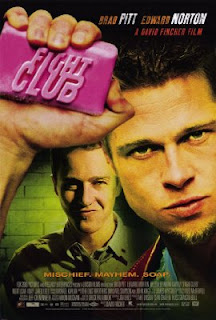
Fight Club (1999) – Directed by David Fincher.
Use of Camera:
As soon as the scene begins, the director uses a extreme close up to introduce us to a important prop on the action, but as it is a XCU, it is not clear for the audience to understand straight away what the prop is, so depth of field is used therefore the image of the gun in the foreground goes out of focus, it becomes blurred and the image of the man with the gun inside his mouth is suddenly sharp. So the audience’s focus is on the man, and by this one shot the viewer immediately knows that his life is at risk.
The protagonist is sitting down, whereas the antagonist is standing up, so the camera is filming the protagonist from a high angle, which makes him look more vulnerable, smaller.The little of the villain which is being filmed, is filmed from a low angle which makes him look taller, stronger, more threatening to the protagonist.
Special Effects:
The graphics at beginning of this film are meant to be impulses purely based on fear, it is the fear center in the nameless narrator’s brain. This was beautifully used in order to entertain and engage the audience, since it gives the feeling of what kind of film they will be watching, it shows that there will be action and that it will be thrilling.
Editing:
The very beginning of this opening sequence it is indeed very interesting to look at, it’s in a way abstract and surreal, the viewer can’t comprehend what is being shown straight away, particularly because of the fast pace which was used in this, which creates tension and therefore helps to build to the climax, also creates an enigma which makes the audience curious, consequently grabbing their attention, engaging them to carry on watching the film.
Mise-en-scene:
The protagonist tied up on the chair is sweating, this can connote that he is nervous, scared and this helps to build up the tension in the audience. The narrator is not wearing trousers, he is only wearing a shirt and a underwear, this connotes that he is even more vulnerable. He also has under eye bags which implies that he hasn’t been sleeping properly as he has probably being held in hostage for days or that he simply has insomnia, which we find out later it is indeed his case. There is a contrast between the mise-en-scene of the protagonist and the antagonist, the narrator looks restless, skinny, weak, tied up on a chair, he is helpless and vulnerable whereas the antagonist is tall, strong, he looks like a body builder as he is wearing a vest which makes his muscles stand out, he is a free man as he is not tied up on a chair, he has a gun therefore he is under control.
Sound:
Non-diegetic sound: Up beat song playing at the very beginning, the genre of the song is rock, the song matches the image, it is not contrapuntal at all, it fascinates the audience and sets an atmosphere for the film, the upbeat song can imply that the film will definetly be thrilling, and that there will be a lot of things going on, and it will be interesting. Diegetic sound : “(...)And I wondered how clean that gun was.” The narrator is disgusted about the dirtiness of the gun inside his mouth, which ain’t a stereotypical reaction at all, this suggests that he is not normal, that he is not sane, for he is worrying about the wrong things, that’s what makes him a unique and amusing character.
Conclusion:
Lastly, David Fincher uses a brilliant technique in Fight Club, also used by Quentin Tarantino in Reservoir Dogs, he edited the sequence of the film so it would begin with it’s last scene. The film opens with the climax, confusing the audience but at the same time engaging them, creating mistery and enigma, making them curious, therefore grabbing their attention and keeping them watching so then, they can understand what is going on. An example of enigma, which was used in this opening sequence, was the fact that the antagonist’s face was hidden, and so was his identity as he doesn’t mention his name. This evokes curiosity and interest in the viewer.
This opening scene also introduces themes, such as Violence and Crime, props such as fake blood and guns are used as they are iconic symbols of Crime and Violence in thriller films.
This opening title establishes characters through the use of dialogue.When the nameless narrator says: “(...)And I wondered how clean that gun was.” This suggests that he is not normal, he is not an average guy, otherwise he wouldn’t be wondering about how clean the gun was, but about his life. His reaction to the situation is not stereotypical, that helps to make him the intriguing and interesting character that he is.
No comments:
Post a Comment